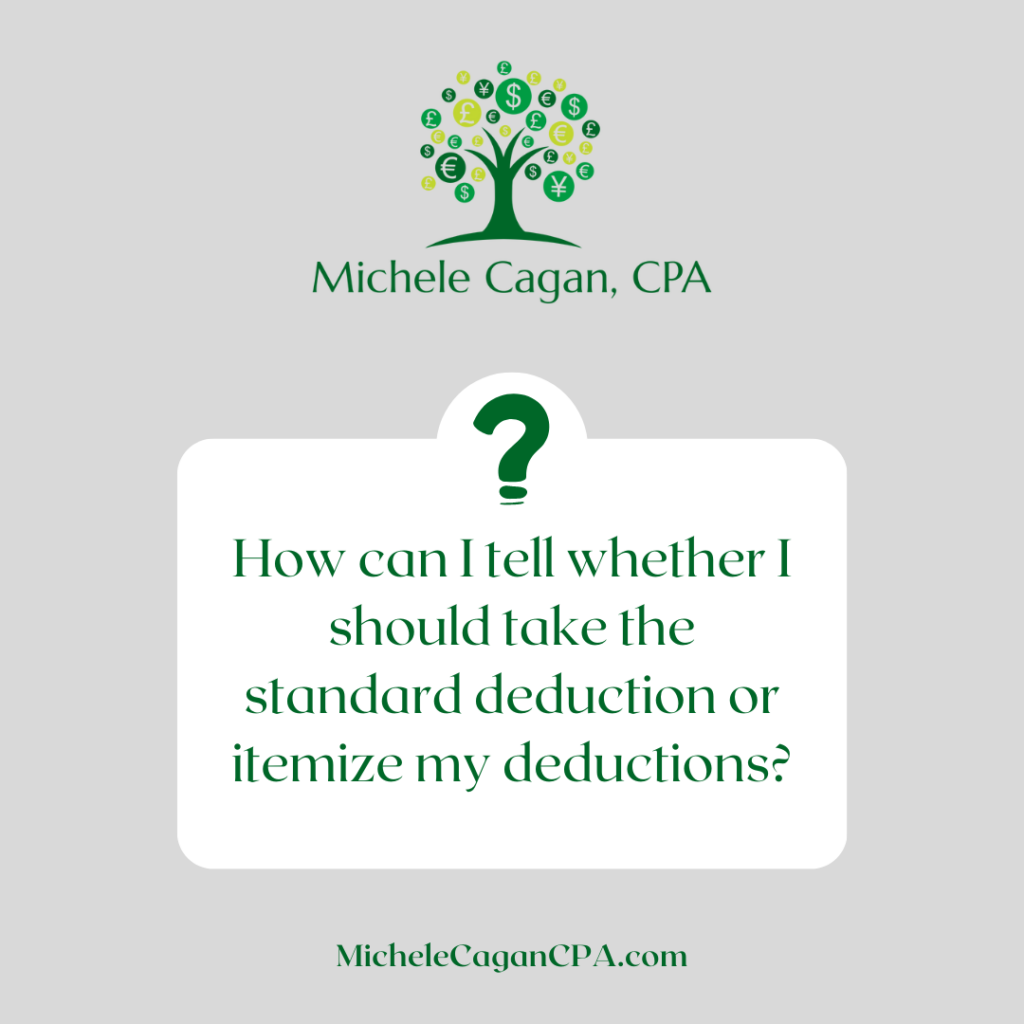Q. How can I tell whether I should take the standard deduction or itemize my deductions?
A. If your itemized deductions will be more than your standard deduction, itemize away! Of course, with higher standard deductions, fewer people than ever are itemizing. But that doesn’t mean you shouldn’t if it will help lower your tax bill. Here are some of the itemized deductions that you can take:
Unreimbursed medical expenses greater than 7.5% of your adjusted gross income (AGI). That means ANY medical expenses you paid this year and didn’t get reimbursed for this year. It also includes things like:
- mileage driven or transportation costs to get to medical appointments
- dental and vision care
- diabetes supplies
- acupuncture
- pregnancy test kits
- breast pumps
- chiropractic care
- LASIK
- Long-term care insurance premiums
You can find more information about deductible medical and dental expenses here.
Mortgage interest, which may include points paid to get a better mortgage interest rate.
State and local taxes (SALT), which include property taxes, state and local incomes taxes, and sales taxes up to a total of $10,000.
Charitable donations, which include cash, stuff, and miles driven to volunteer.
Most DIY tax software will let you run your taxes both ways if you enter the potential itemized deductions. That way you can see for sure which will save you more money in taxes. And if you pay a tax preparer, they can absolutely figure it out for you.

Q. Is there still a child tax credit? How can I claim it?
A. Yes, there’s still a child tax credit, but it’s gone back to pre-Covid rules. That means fewer people will qualify, and the maximum credit is smaller – up to $2,000 for each qualifying child. Up to $1,500 of that may be refundable, meaning it can increase your tax refund rather than just lowering your tax bill.
Here are the basic rules for a qualifying child (click here for more information)
- The child had to be under 17 as of December 31.
- The child has to have a Social Security number.
- They have to be your child, stepchild, foster child, brother, sister, grandchild, or other related child.
- The child didn’t provide more than half of their own support for the year.
- The child had to live with you for more than half the year. Temporary absences, like a kid away at college that you’re supporting, still count as living with you.
- The child has to be a U.S. citizen.
- The child has to qualify as a dependent on your tax return.
The full credit starts to phase out if your income is over $200,000 for single and head of household filers, or $400,000 for married filing jointly.
Your tax software or your tax preparer know all ins and out of these rules, and will help you figure out if you qualify for the credit. To take the credit, you’ll need to include a completed Schedule 8812 with your tax return.
Q: Will I save money filing as “head of household” instead of single? If so, how do I know if I qualify?
A: Absolutely! If you qualify to file as head of household (HoH) – as most single moms do – you’ll get a larger standard deduction and better tax rates. That can mean a much lower tax bill for you. Here’s how to qualify:
- You’re single, divorced, or separated.
- You’ve lived apart from your ex-spouse for at least the last six months of last year.
- Your kids live with more than half the time (even one extra day counts).
- You support a qualifying child.
- You paid more than half of the support for your household.
The IRS is very strict about proof for this tax status. They require tax preparers to perform due diligence, so don’t be surprised when your tax preparer – or tax software – asks questions to make sure you qualify.
Q: How I can file my taxes for free?
A: If you earned $73,000 or less, you qualify for the IRS Free File program. And if want to really file for free, make sure go through the IRS Free File page… and not a tax software company’s “free file” option which may not actually be free.
Many software companies claim they offer “free” tax prep software. But you could end up paying for e-filing, your state tax returns, or uncommon forms.
Q: Can I put money in a 401(k) AND a Roth IRA?
A: Yes, you can! As long as your income doesn’t exceed the IRS limits for Roth IRAs, you can definitely contribute to both. Those limits change every year, so make sure you have the most recent information. Here’s a quick link to the Roth IRA income limits for 2022. Remember that you can make 2022 contributions to your Roth IRA until April 17, 2023.
Q: What’s the difference between a tax credit and a tax deduction?
A: A tax credit directly reduces the amount of tax you have to pay, sort of like a discount coupon. So if you owe $1,000 in taxes and have a $300 tax credit, you’d only have to pay $700.
A tax deduction reduces the amount of income you have to pay tax on. So if your total income is $60,000 and you have a $300 tax deduction, your taxable income would drop to $59,700. Based on 2022 tax tables for single filers, that would reduce your taxes by $66 ($300 x 22%).
Bottom line: Tax credits are better than tax deductions – but both will lower your tax bill. Find and take as many as you legally can.

